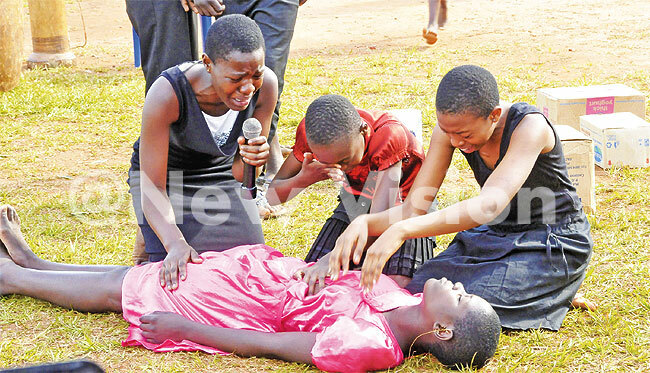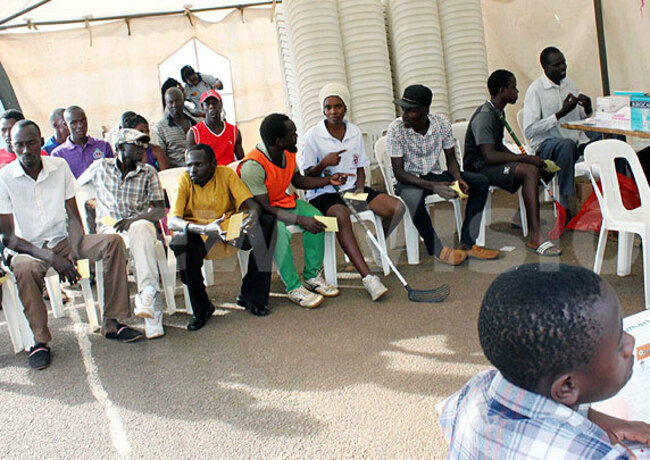Why women are more prone to HIV infection
Socio-cultural norms are still a big contributing factor in the spread of HIV/AIDS among women and girls in Uganda.
UNITED AGAINST HIV/AIDS

In the run-up to World AIDS Day (December 1), for the whole of November, Vision Group media platforms are airing and publishing in-depth articles about the disease.HIV disproportionately affects women and adolescent girls because of vulnerabilities created by unequal cultural, social and economic status, writes Vivian Agaba.
#GetTested4HIV
______________________________
For the 32 years Uganda and the rest of the world have grappled with HIV and AIDS, no one has been spared; men, women, infants, adolescents and youth have all been infected and affected.
In Uganda, about 1.5 million people are living with HIV/AIDS, but an analysis of data shows that new infections are more in females than males. For instance, in 2015, it was estimated that 567 young people aged between 15-24 years get infected with HIV every week and of these, 363 were girls.
A 2016 report shows that 570 young women aged 15-24 years got infected with HIV every week in Uganda.
A 20-year study by the Uganda Virus Research Institute and the Medical Research Council in Kyamulibwa, Kalungu district whose results were released in 2015 showed that Ugandan women with HIV who are not on treatment die faster than their male counterparts.
The research shows that girls who acquire HIV at age 15 die at 37 years on average, compared to 42 years for men.
According to the 2017 Joint United Nations Programme on HIV and AIDS (UNAIDS) country factsheet, there are are 750,000 women aged 15 and above living with HIV, whereas men of the same age group are 440,000.
In the same factsheet, the prevalence rate for women aged 15 to 49 years stands at 7.3% compared to men of the same age group whose prevalence rate is at 4.5%.
Why women make up more new infections
Several factors are known to put women and adolescent girls at a higher risk of contracting HIV than any other categories.
Dr Dan Byamukama, the head of HIV/AIDS prevention at the Uganda AIDS Commission, says the factors can be categorised into behavioural, biological and societal/structural.

Children presenting a play about HIV/AIDS with messags of awareness to the parents and the communities
Social-cultural norms
Socio-cultural norms are still a big contributing factor in the spread of HIV/AIDS among women and girls in this country.
Giving an example of the Karamoja region, Charles Onyang, a health educator and HIV/AIDS focal person for Moroto district, reveals that practices such polygamy (though on the decline), child marriages, widow inheritance and female genital mutilation (FGM) expose girls and women to HIV/ AIDS.
"We have older men marrying girls below the age of 18 and yet in many cases, the man already has more than two wives. If the man is infected with HIV/AIDS, he is likely to pass it on to his wives," he says.
According to Avert, an international HIV and AIDS charity organisation based in the UK, as of last year, about one in seven adolescent girls (aged 15 to 19) in the world were married or in union.
It is noted that girls who get married are more likely to be beaten or threatened by their husbands and are more likely to describe their first sexual intercourse as forced compared to those who get married after turning 19.
Child brides are rarely able to assert their wishes, such as whether to practice safe sex, which increases their risk of HIV.
FGM is another pathway for HIV/AIDS among women and girls. Research has shown that instruments such as the same razor blades may be used to cut different women, which is risky," he added.
According to Byamukama, because of patriarchy, men end up making most of the decisions in a relationship such as when a couple should have sex. He adds that the majority of Ugandan women are not empowered to negotiate safe sex , for example, asking a man to use a condom.
Such a scenario puts women at risk of contracting HIV.
"There is need to empower women to enable them to negotiate for sex safe and asking men to test for HIV/ AIDS," he said.
Gender-based violence
In addition, Dr Yunia Mayanja, a researcher with Medical Research Council (MRC), UVRI and London School of Hygiene and Tropical Medicine, says intimate partner violence, which includes physical and sexual violence has also contributed to the higher new HIV infections among women.
"We have heard stories where women have been beaten for denying their partners sex," she notes.
The Uganda Demographic Health Survey (UDHS) 2016 showed a decline in the prevalence of genderbased violence (GBV), but the vice still exists, so the struggle to fight it should not cease.
In Uganda, more than one in fi ve women aged 15-49 years (22%) reported to have experienced sexual violence committed by an intimate partner compared to 8% of men.
Poverty
Byamukama notes that poverty is another major factor that pushes adolescents and young women into early marriages, getting multiple sexual partners and transactional sex to make ends meet.
All these make them vulnerable to HIV infection.
No knowledge about HIV prevention
Byamukama notes that research has shown that among adolescents and young women (15-24 years), only 46% of them know how to prevent HIV; the remaining 54% do not have accurate information on how to avoid the transmission of HIV/AIDS from person-to-person.
On the other hand, he adds that lack of access to a preventative protection method directly under the control of women limits their chances of protecting themselves.
"The male condom is more popular and men can use it to protect themselves against contracting HIV/ AIDs. On the other hand, the female condom is very expensive and not easily accessible," Byamukama says.
In 2016, only 900,000 female condoms were bought, while in the same year, 300 million male condoms were bought.
According to Byamukama, female condoms have been unpopular in Uganda, with activists calling for their remodelling. In addition, two years ago, officials in the health ministry said they would stop the purchase of female condoms due to limited demand as they were lying idle in many health facilities across the country.

One important ingredient of the HIV/AIDS fight is HIV testing, and many Ugandans are embracing the culture
Reversing the trend
Mayanja notes that women and girls are more at risk of HIV because they have greater biological risks due to the larger surface area of the female genital area which provide increased opportunity for infection after exposure.
So what needs to be done to reverse the trend?
The Government together with different partners at local, national and international level are engaged in different activities/programmes to reduce HIV/AIDS infections among women and girls.
Last year, President Yoweri Museveni launched a five-point plan on fasttracking the ongoing efforts to end HIV/Aids as a public health threat in Uganda by 2030. The initiative aims to engender a renewed country focus to ensure Uganda drastically reduces new infections (particularly among young women and girls).
In 2017, the President also endorsed the "Let girls be girls" campaign to prevent them from getting married early and encourage them to stay in school.
"When girls are encouraged to stay in school, they are able to delay sex until they finish school. This reduces the chances of dropping out of school, but also engaging in early sex that may expose them to HIV/AIDS," Byamukama says.
He further points out that there is need for the Government to come up with programmes that support women and girls to start incomegenerating activities to empower them economically, so that they do not over depend on men.
Different organisations have engaged cultural and institutional leaders in the elimination of practices such as forced child marriages, widow inheritance and FGM.
Byamukama also suggests that there is need to empower women and young girls to freely and openly report offences of rape and defilement after they have happened, so that they are taken to health facilities for post-exposure prophylaxis (PEP).
Also known as post-exposure prevention, is any preventive medical treatment started after exposure to a pathogen, in order to prevent the infection from occurring.
On the other hand, Mayanja mentions categories under which more efforts should be directed.
Structural interventions
Government programmes and research centres should prioritise interventions that minimise negative norms, power-imbalance, decision making structure and other socioeconomic factors that affect female, sexual minorities and adolescent girls both within the research context and outside of the research context.
Research processes and environment
Interventions that analyse and integrate gender in all research processes should be prioritised.
There should be investment in creating a conducive environment for female participants with children, or adolescent girls or sexual minorities. Gender transformative monitoring and evaluation and learning Government programmes and research centres should develop and implement a monitoring and evaluation and learning process on gender.
All in all, there is hope and the struggle continues. Experts believe that one day, Uganda and the world will be free of the HIV/AIDS scourge.
Continental figures not any different
Since the start of the HIV/AIDS epidemic, women around the world have been disproportionately affected by HIV in many regions.
Today, women constitute more than half of all people living with HIV/AIDS. AIDS-related illnesses remain the leading cause of death for women of reproductive age (15-44).
According to international HIV and AIDS charity organisation Avert, young women (15-24 years) and adolescent girls (10-19) in particular, account for a disproportionate number of new HIV infections.
In 2016, new infections among young women aged (15-24) were 44% higher than men their age.
In eastern and southern Africa, young women made up 26% of new HIV infections despite only accounting for 10% of the population. Some 7,500 young women across the world acquiring HIV every week.
In east and southern Africa, young women will acquire HIV five to seven years earlier than their male peers. In 2015, there were on average 4,500 new HIV infections among young women every week, double the number in young men. In west and central Africa, 64% of new HIV infections among young people in 2015 occurred among young women.
The difference is particularly striking in Cameroon, Côte d'Ivoire and Guinea where adolescent girls aged 15-19 are five times more likely to be infected with HIV than boys of the same age.
EDITOR'S NOTE: Empowerment will make women less vulnerable to HIV infection
Data shows that when it comes to new HIV cases, women are more affected than men.
Researchers have identified several risk factors that make women more vulnerable to HIV infection. These can be categorised into biological, behavioral and social-cultural.
Although nothing can be done about the biological factors, such as the anatomy of the woman, a lot can be done about the other factors. Such factors include the social-cultural factors that involve the disempowerment of women making them unable to negotiate safe sex.
Data shows that because of the way women are brought up, many not only fear to talk about sex, but they cannot bring themselves to ask their spouse to go for testing or use condoms.
As we get ready to commemorate World AIDS Day, all stakeholders should invest in the empowerment of women, including the economic aspect of it, as a way of protecting them from HIV and AIDS.
Also related to this story
Born with HIV: Adolescents join the fight
How HIV/AIDS fight started in Uganda
Is cancer the new face of HIV/AIDS?
HIV/AIDS pandemic lingers despite successes
HIV: Our exclusive historical gallery of the disease